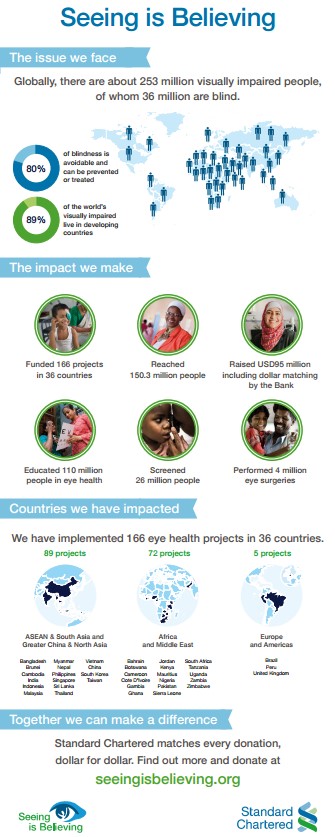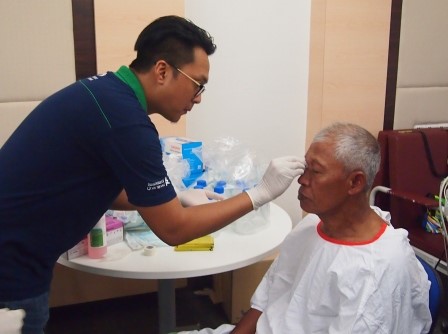Around 39 million people in the world today are blind, most of them living in the developing world. Yet, in eight out of ten cases, blindness can be prevented or treated with proven, cost effective interventions.
Through Seeing is Believing (SiB), we’ve partnered with the International Agency for the Prevention of Blindness (IAPB) and leading international eye-care non-governmental organisations to improve access to eye-care across our markets.
We are committed to raising USD100 million for SiB between 2003 and 2020, with the bank matching every dollar. As of the end of 2016, through fundraising and bank matching, we've raised USD92.8 million.
Learn more about Seeing is Believing at seeingisbelieving.org
In Malaysia, Standard Chartered Bank contributes towards avoidable blindness through the Intraocular Lens (IOL) project in partnership with the Ministry of Health. From 2013 to 2016, the Bank through its charity arm, Standard Chartered Foundation (SCF) contributed MYR1.5 million to cover the costs of over 4,400 intraocular lenses required for cataract surgeries for underprivileged patients across Malaysia.
In 2017, SCF further committed MYR412,000 to phase 2 of IOL project that will result in approximately 1,800 lenses being donated.
In 2018, Standard Chartered Malaysia will contribute an additional USD55,000 towards the IOL project to help give back the gift of sight to more Malaysians.
| Address | Level 11, Menara Standard Chartered, 30 Jalan Sultan Ismail, 50250 Kuala Lumpur |
| Phone | - |
| [email protected] | |
| Contact Person | Sophia Nur Iman Ramli |
| Website |
https://www.sc.com/en/sustainability/investing-in-communities/seeing-is-believing.html |
| Tax-Exempt LHDN No. | No tax exemption receipts will be issued for donations to Seeing Is Believing |
RUN FOR A REASON AND HELP OTHERS SEE
You can help change thousands of lives through the gift of sight by raising funds towards Seeing is Believing (SiB).
Blindness prevention and sight restoration are some of the most cost effective health interventions available and provide engaging and tangible opportunities for people to get involved.
The International Agency for the Prevention of Blindness (IAPB), the World Health Organisation (WHO) and all of the dedicated eye-care professionals who are making significant strides in eliminating avoidable blindness need our support to ensure that this cause remains a priority
Funds raised for SiB are invested in eye health projects that range from providing comprehensive eye care in low and middle-income countries to building innovative eye health delivery solutions.
How your donations can help?
Cataract operation for an adult
Cataracts remain the leading cause of visual impairment. 47.9% of the world’s blindness is caused by cataracts. Due to the lack of eye-care services, cataract-related visual impairment occurs far more frequently in low and middle-income countries than it does in high-income countries. Although cataracts can’t be prevented, they can be treated. For as little as USD30 and within 15 minutes, a sight-restoring cataract surgery can change a person’s life.
Eye-care training for ten primary health care workers
Primary health care (PHC) workers are critical in health care delivery especially in poor and rural communities. PHC workers are the unsung heroes in health systems and crucially, they are often members of the communities where they operate. With good quality training in eye-care, PHCs can remedy basic eye problems, which left untreated, could cause irreparable damage. Training also provides PHCs with the knowledge of how, when, and where to refer more serious cases.
Paediatric eye surgery subsidy for one child
Paediatric eye surgery costs vary greatly. Regardless of the location, for children whose families do not have medical insurance, the expense is usually prohibitive and lack of action often results in children losing their sight. By helping to alleviate the majority of costs, many more underprivileged children will gain access to the surgery they need.
According to the Vision Loss Expert Group, the global prevalence of visual impairment has dropped from 4.58 per cent in 1990 to 3.38 per cent in 2015. The decline indicates that the collective efforts of medical professionals, civil society organisations, governments and corporations, including Seeing is Believing, are leading to meaningful change across the world.

